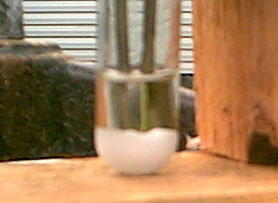
May 4, 2004

This was an attempt to make potassium metal through electrolysis of potassium hydroxide. As you can see I fashioned a U-tube type apparatus from commonly available metal pipes. The electrodes inserted into them are nickel and the anode is on the right, cathode on the left. KOH was put into the tube and water was added to make it conductive the electrolysis was commenced. However I think I added too much water, and it ended up electrolyzing water most of the time. Once everything was liquid I poured some mineral oil over the top since the MSDS for it stated that it would be below its boiling point and it is inert to potassium, although I wasn't sure about how inert it would be to molten hydroxide.
On the good side the cell division worked, just look at the color separation above. On the bad side the mineral oil spattered, foamed over, and broke down. No potassium was visibly formed, when the electrodes touched the side of the container the amps that the cell was consuming went way up and it tried to short out so it was best with the electrodes hanging there without touching anything. I believe the purple color very apparent at the anode was formed due to either anodic oxidation of the iron in the pipe to ferrate or less likely the manganese alloyed in the iron to permanganate, either way the color was quite unexpected, if the water had been greatly reduced and the KOH heated by heat alone then this reaction could have probably worked considerably better.
May 22, 2004

Attempted electrolysis of lithium chloride with nickel electrodes in DMSO, Acetone, Acetonitrile, Nitrobenzene, methanol, benzene, kerosene, mineral oil, and toluene. Only DMSO gave any reasonable result, the cathode fizzing after contact with water possibly a tiny amount of lithium on it, the solution of DMSO turned red and green and gave off weird smells from the reaction. Methanol changed to an off yellow color and reacted quickly but lithium would have reacted with it anyway.
Currently attempting to make ethylene carbonate, it is a medium for lithium based batteries and seems like it might make a good alternative, tired to make it on December 4, 2004.
May 27, 2004

On this day I tried fusing Fe2O3 with NaNO3, it failed, NaOH or KOH is necessary in this reaction and I neglected it for fear of it attacking my crucible heavily. Therefore I got no reaction. However, my second attempt at ferrate my of provided something.
I tried electrolysis of a concentrated KOH solution with iron electrodes. The solution was so concentrated as to have solid KOH at the bottom of the solution even though it was roughly 100C at the time of electrolysis. Purple foam floated across the top, a good indicator of a high oxidation state. The reaction was quenched by pouring it into ice water after electrolyzing for 20 minutes. It has recently come to my attention that electrolysis with AC rather then DC results in better results for this but I preformed this reaction with DC. I was left with a red solution, filtration gave a red solution still, adding BaCl2(aq) formed a precipitate which is visible in picture #3 and after decantation #4. Picture 5 shows its reaction with HCl, it dissolves completely, no barium chloride precipitate like I expected had it been a barium salt, there is a chance that it could have been ferrate but I was unable to confirm.